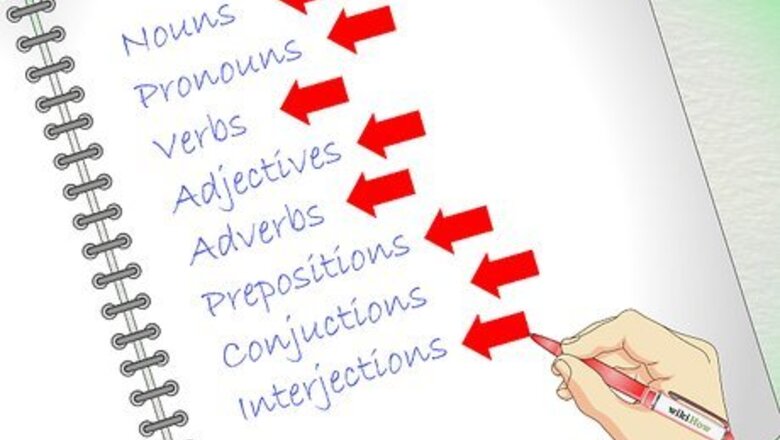
views
Parsing the Parts

Learn the parts of speech. The words in a sentence are given names according to the type of function they serve in the sentence. There are 8 parts of speech: Nouns are words that represent persons, places, or things. Examples include ‘’boy,’’ ‘’girl,’’ ‘’cat’,’ ‘’dog’,’ ‘’grass’’, and ‘’home’’. Pronouns are words that stand in for nouns so they don’t have to be repeated. Examples include ‘’he,’’ ‘’she,’’ ‘’it,’’ ‘’you,’’ ‘’we,’’ and ‘’they.’’ Verbs are words that express action or state of being. Examples include ‘’is’’/’’are’’, ‘’do’’/’’does’’, ‘’has’’/’’have’’, ‘’perform’’, and ‘’sing’’. Form of verbs, called verbals, can serve as other parts of speech. Gerunds are verbals that act as nouns; they usually end in ‘’-ing’’ (as in ‘’acting,’’ the profession). Participles are verbals that act as adjectives; they usually end in ‘’-ing’’ or ‘’-ed’’ (as in ‘’melted’’ when describing melted chocolate). Adjectives are words that describe, or modify, nouns. Examples include words representing size (‘’big’’, “huge’’, ‘’small’’, ‘’tiny’’), color (‘’red’’, ‘’green’’, ‘’blue’’), quantity (‘’one’’, ‘’two’’, ‘’three’’), or condition (‘’good’’, ‘’bad’’, ‘’happy’’). A special group of adjectives are called articles or determiners; these include ‘’a’’, ‘’an’’, and ‘’the’’. Adverbs are words that describe verbs, adjectives, or other adverbs. Many adverbs end in ‘’–ly’’ (‘’quickly’’, ‘’badly’’, ‘’really’’), but others do not (‘’very’’, ‘’fast’’). They describe how, when, where, why, and how much. Prepositions are words that connect nouns to other words so they can describe those words. Examples include ‘’at’’, ‘’in’’, ‘’on’’, ’’before’’, and ‘’after’’. Conjunctions are words that connect other words or parts of sentences together. Examples include ‘’and’’, ‘’but’’, and ‘’or’’, as well as ‘’because’’ and ‘’when’’. Interjections are words exclaimed to represent outbursts of emotion or pain. Examples include ‘’hello’’, ‘’ouch’’, and ‘’oh’’. Interjections are followed by commas when the feeling is mild, or by exclamation points when the feeling is strong. Some words can be used as more than one part of speech, depending on where they are placed in a sentence. The word ‘’well’’ can be used as a noun (place where water is drawn from), an adjective, an adverb, or as an interjection, for example.
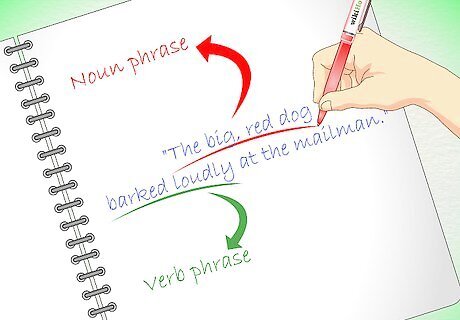
String words together into phrases. A phrase is a grouping of one or more words that conveys an idea, usually about something that exists or some type of action, and may include other words that modify it. The most important word in the phrase is called its head. Some of the types of phrases are given below: A noun phrase is a phrase built around and including a noun. In the sentence ‘’The big, red dog barked loudly at the mailman.’’, ‘’The big, red dog’’ is a noun phrase, with ‘’dog’’ the noun that forms the head of the phrase; the words ‘’big’’ and ‘’red’’ describe, or modify, it. Noun phrases can also be built around gerunds, as in ‘’loud, repeated barking’’. A verb phrase is a phrase built around and including a verb. In the sentence above, the phrase ‘’barked loudly’’ is a verb phrase, with ‘’barked’’ the verb that forms the head of the phrase; the word ‘’loudly’’ describes, or modifies, how the dog barked. An adjective phrase is a phrase built around an adjective. In the sentence ‘’I am fond of peanut butter.’’, ‘’fond of peanut butter’’ is an adjective phrase with ‘’fond’’ as its head. An adverb phrase is a phrase built around an adverb. In the sentence ‘’The mailman ran very rapidly from the barking dog.’’, ‘’very rapidly’’ is an adverb phrase with ‘’rapidly’’ as its head. An appositive is a phrase that adds detail to the sentence but won’t change the sentence’s meaning if it’s removed. In the sentence ‘’The big, red dog, an Irish setter, barked loudly at the mailman.’’, the phrase ‘’an Irish setter’’ is an appositive. Appositives are set off by commas. If the appositive is a name used to address someone, it’s called a vocative. A prepositional phrase is a phrase that begins with a preposition and includes one or more nouns that serve as objects of the preposition. The phrase ‘’at the mailman’’ is a prepositional phrase beginning with the preposition ‘’at’’ and including the noun ‘’mailman’’ as its object. A prepositional phrase typically acts as an adjective or adverb. Phrases can contain phrases of the same or different kinds within themselves. For example, the prepositional phrase ‘’at the mailman’’ contains the noun phrase ‘’the mailman’’. Likewise, the adjective phrase ‘’fond of peanut butter’’ includes the prepositional phrase ‘’of peanut butter’’.

Look for phrases that form subjects and predicates. To be complete, a sentence must have a word or phrase that serves as its subject and a word or phrase that serves as its predicate. The subject is a noun phrase that tells what the sentence is about. It’s what does the action or experiences the state of being described in the predicate. In the sentence, ‘’The dog barked.’’, “dog” is the subject, or more correctly, the simple subject. (‘’The dog’’ can be called the complete or entire subject.) The predicate is a verb phrase that tells the action the subject performs or the state of being the subject experiences. In the sentence, ‘’The dog barked.’’, ‘’barked’’ is the predicate. In a longer sentence, such as ‘’The dog barked loudly.’’, ‘’barked’’ is the simple predicate, while ‘’barked loudly’’ is the complete predicate.
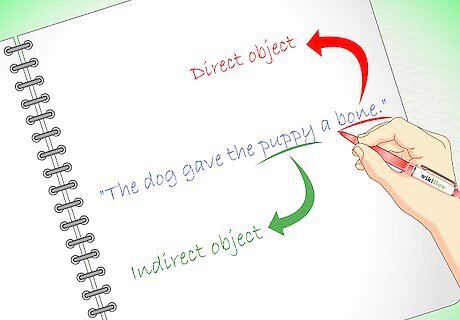
Identify the object, if there is one. Some sentences also have an object, which is the part of the predicate that tells who or what received the action the subject is performing. Objects can be either direct or indirect. A direct object is one that the action was done on; it can be the answer to the question “Who?” or “What?” In the sentence, ‘’The dog gave the puppy a bone.’’, ‘’bone’’ is a direct object. An indirect object is one that the action was done for. In the sentence, ‘’The dog gave the puppy a bone.’’, ‘’puppy’’ is an indirect object. (An indirect object functions the same as a prepositional phrase beginning with the preposition “to” or “for” that could be written after the direct object, as in ‘’The dog gave a bone to the puppy.’’) Verbs that can be followed by an object are called transitive verbs; those that can’t be followed by an object (other than the object in a prepositional phrase) are called intransitive verbs.
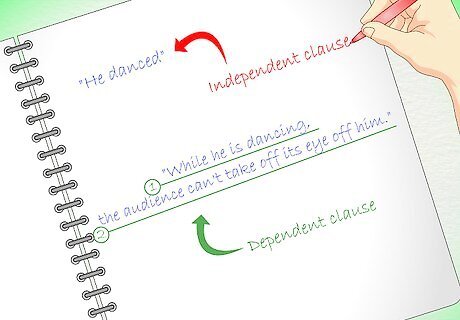
Combine subjects and predicates into clauses. A clause is any portion of a sentence that includes both a subject and a predicate. There are two main types: independent and dependent clauses, with dependent clauses further divided into subtypes. An independent clause can stand alone by itself as a complete sentence if all other information is removed. A sentence can have more than one independent clause; multiple independent clauses are connected with a coordinating conjunction (‘’and’’,’’ or’’, ‘’nor’’, ‘’but’’, ‘’so’’, ‘’yet’’) or a semicolon. A dependent clause cannot stand alone by itself but instead requires another clause to express a complete thought. (The frustrated parent’s reply of “Because I said so” is an example of an incomplete sentence made of a dependent clause.) Dependent clauses can function in sentences as nouns, adjectives, or adverbs. Dependent clauses may be introduced by subordinating conjunctions (‘’although’’, ‘’because’’, ‘’if’’, ‘’since’’, ‘’unless’’, ‘’when’’, ‘’while’’). These kinds of dependent clauses are called subordinate clauses. Dependent clauses may be introduced by relative pronouns (‘’who’’/’’whom’’/’’whose’’, ‘’what’’, ‘’which’’, ‘’that’’). These kinds of dependent clauses are called relative clauses. Dependent clauses that are essential to the meaning of the sentence because they limit what the sentence refers to are called essential or restrictive clauses. They are not set off by commas. In the sentence ‘’The big, red dog that lives on Pine Street barked loudly at the mailman.’’, the clause ‘’that lives on Pine Street’’ is a restrictive clause because it identifies a specific dog. Dependent clauses that add information that isn’t essential to the meaning of the sentence are called nonessential or nonrestrictive clauses. Like appositives, these clauses are set off by commas. In the sentence ‘’The big, red dog, which is seven years old, barked loudly at the mailman.’’, the clause ‘’which is seven years old’’ is a nonrestrictive clause because the dog’s age isn’t important information.
Analyzing a Sentence
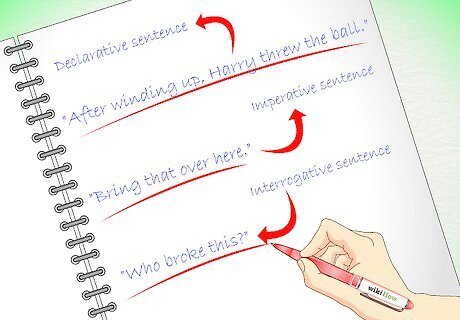
Look for the subject of the sentence. As noted earlier, the subject is a noun phrase (or a pronoun) that tells what the subject is about. The subject also determines the form the verb in the predicate takes. In a simple declarative sentence (statement) or exclamatory sentence (‘’Harry threw the ball’’, ‘’I did it!’’), the subject is usually stated first. In a declarative sentence introduced with an appositive or a nonrestrictive clause (a complex sentence), the subject usually appears shortly after the comma that sets off the appositive or clause. (‘’After winding up, Harry threw the ball.’’) In an imperative sentence (command), the subject is usually not stated. (‘’Bring that over here.’’) It is understood to be whoever the command is given to, or more simply, “you.” In an interrogative sentence (question), the subject can sometimes begin the sentence (‘’It’s raining in Nebraska?’’, ‘’Who broke this?’’), but it can also follow the predicate (‘’Is this your car?’’) or fall between parts of it (‘’May I have this dance?’’). Often, you can rewrite the question into a statement (‘’This is your car.’’); in those cases, the subject of the statement is also the subject of the question. A sentence can have more than one subject. Multiple subjects are called a compound subject; the individual subjects are usually connected with the conjunction ‘’and’’.
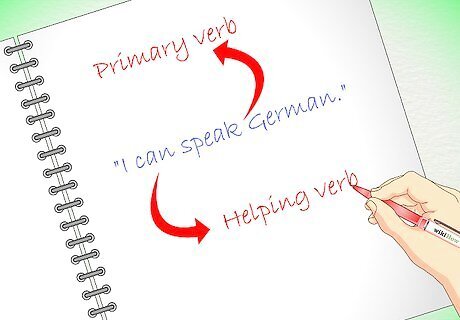
Find the verb and you find the predicate. Also as noted earlier, the predicate tells what action the subject is taking or has taken or the subject’s state of being. In most sentences, the predicate immediately follows the subject, while for interrogative sentences, the predicate verb usually comes before the subject. The predicate may include a main verb and a helping verb, as in ‘’I can speak German’’. ‘’Speak’’ is the primary verb, but ‘’can’’ serves as a helping verb, telling that I am able to speak German. The primary helping verbs are the forms of ‘’be’’, ‘’do’’, and ‘’have’’, while ‘’can’’ is part of a group of helping verbs that expresses need or possibility, called modal helping verbs. The others are ‘’could’’, ‘’may’’, ’’might’’, ‘’must’’, ‘’ought to’’, ‘’shall’’, ‘’should’’, ‘’will’’, and ‘’would’’. Just as a sentence can have more than one subject, it can also have more than one predicate. Multiple predicates are called a compound predicate; the main verbs are usually connected with the conjunction ‘’and’’.
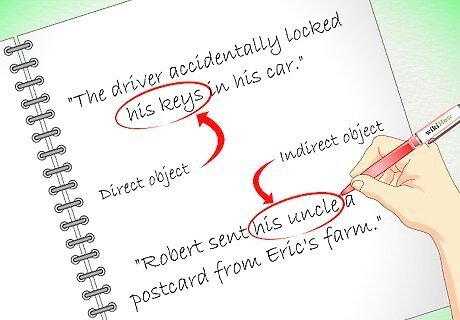
Look for the direct and indirect objects, if they’re present. Objects, when present, typically follow the verb in the predicate. A verb followed by one or more objects is called a transitive verb, while a verb that isn’t followed by an object is called an intransitive verb. An indirect object often follows the verb immediately, while a direct object may be preceded by modifiers or an indirect object. A sentence may have multiple direct or indirect objects. Not all nouns or pronouns that follow the predicate verb are objects, however. If the verb just connects the subject to a noun that describes it (‘’I am a man.’’), the noun that follows the verb is called a predicate noun.

Identify modifying words, phrases, and clauses and determine what they modify. Often, you can determine what words modify other words by their position in the sentence. Adjectives are usually placed before the noun they modify, whether it is the subject or the object of the sentence. If several adjectives modify a noun, they may be separated with commas if they describe different attributes of that noun. However, sentences with verbs that connect the subject with information about the subject, called linking verbs, place the adjective after the linking verb, as in the sentence ‘’He is happy.’’ The most common linking verbs are the forms of ‘’to be’’ (‘’am’’, ‘’are’’, ‘’is’’, ‘’was’’, ‘’were’’), ‘’become’’, and ‘’seem’’, but other verbs, such as ‘’appear’’and ‘’feel’’, can also function as linking verbs. Adverbs can be placed either before or after the verb they modify, but usually after. Adverbs that modify adjectives or other adverbs usually come before the word they modify.
Diagramming a Sentence (Parse Tree Diagram)
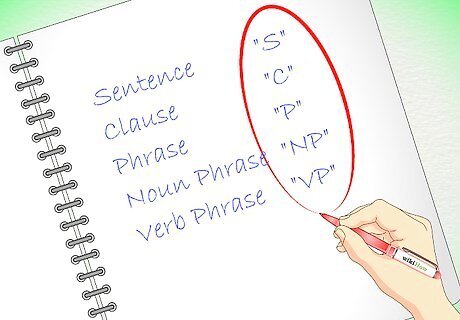
Choose how much of the sentence you want to analyze. Parse trees can be used to analyze a complete sentence or just a clause or phrase within a sentence. If you want to analyze an entire sentence, write the word ‘’Sentence’’ or the abbreviation ‘’S.’’ If you want to analyze a clause, write the word ‘’Clause’’ or the abbreviation ‘’C.’’ If you want to analyze a phrase, write the word ‘’Phrase’’ or the abbreviation ‘’P.’’ You can further define the type of phrase you’re analyzing: a noun phrase (NP), a verb phrase (VP), etc. For the purposes of this example, we’ll use the sentence ‘’The gaudily dressed Wink Martindale remains popular with long-time fans of television game shows.’’
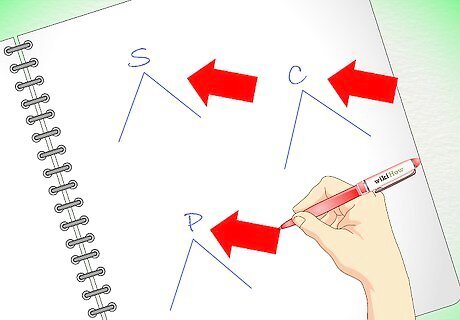
Draw a pair of branching lines downward from the name of the component (S, C, or P). The exact length of each line will vary. For a sentence with a short noun phrase as a subject and a long verb phrase as a predicate, you’ll need to draw a longer line for the subject and a shorter line for the predicate. If the lengths of the two phrases are about the same, your lines should be about the same length.
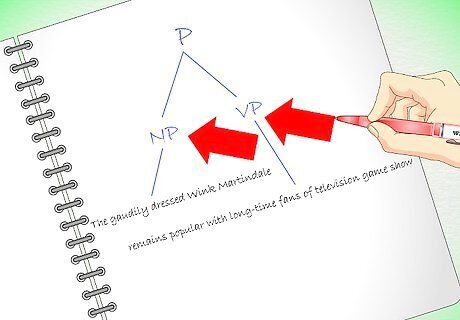
Label the ends of the branching lines. Use labels according to how much of the sentence you’re analyzing and the components that make that part up. If you’re analyzing a complete sentence or a clause, you’re looking for a subject and a predicate. Your subject will be a noun phrase, while your predicate will be a verb phrase. You can use ‘’Noun Phrase’’ or ‘’NP’’ to label the noun phrase as such, or ‘’Subject’’ to label it as the subject. You can use ‘’Verb Phrase’’ or ‘’VP’’ to label the verb phrase as such or ‘’Predicate’’ to label it as the predicate. In our example sentence, the subject is the noun phrase ‘’The gaudily dressed Wink Martindale’’, while the predicate is the verb phrase ‘’remains popular with long-time fans of television game shows’’. If you’re only analyzing a phrase, you’ll only be looking for components that make up the phrase.
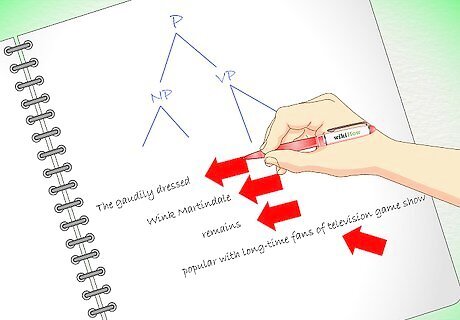
Draw new branching lines from each of the labels. By drawing the new lines, you’re preparing to break down the noun phrase of your subject and the verb phrase of your predicate into their components. The noun phrase ‘’The gaudily dressed Wink Martindale’’ breaks down into an adjective phrase, ‘’The gaudily dressed’’, and the (proper) noun ‘’Wink Martindale’’, so you draw two branching lines from the label ‘’Noun Phrase’’ or ‘’Subject’’. The verb phrase ‘’remains popular with long-time fans of television game shows’’ breaks down into the verb ‘’remains’’ and the adjective phrase ‘’popular with long-time fans of television game shows’’.
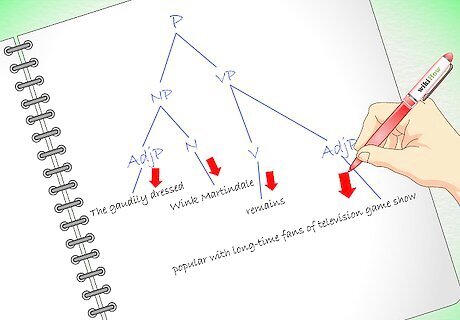
Write labels at the ends of each of the new branches. The labels conform to the parts you’ve identified for the subject and predicate. For the branches created under ‘’Noun phrase’’ or ‘’Subject’’, you’d write ‘’Adjective Phrase’’ or ‘’AdjP’’ and ‘’Noun’’. For the branches created under ‘’Verb Phrase’’ or ‘’Predicate’’, you’d write ‘’Verb’’ and ‘’Adjective Phrase’’ or ‘’AdjP’’.
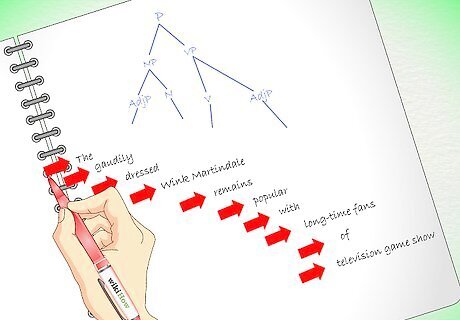
Repeat the branching and labeling until you have a branch and label for each word in the sentence. As noted earlier, types of phrases can be broken down into smaller and smaller component phrases. The adjective phrase ‘’The gaudily dressed’’ breaks down into the article or determiner ‘’The’’ and the adjective phrase ‘’gaudily dressed’’, which, in turn, breaks down into the adverb ‘’gaudily’’ and the participle acting as adjective ‘’dressed’’. The adjective phrase ‘’popular with long-time fans of television game shows’’ breaks down into the adjective ‘’popular’’ and the double prepositional phrase ‘’with long-time fans of television game shows’’. Each of the prepositional phrases breaks down into a preposition and noun phrase (‘’with’’ and ‘’long-time fans’’, and ‘’of’’ and ‘’television game shows’’), and the noun phrases break down further into adjective phrases followed by nouns, and so on.
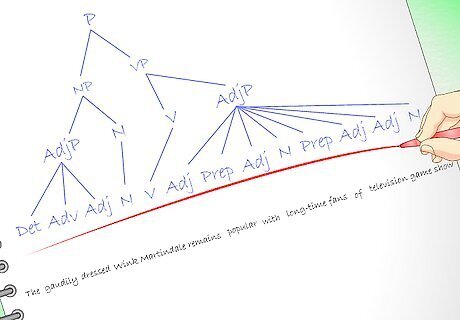
Write the sentence underneath the labels. If you’ve broken the example sentence down completely, you’ll have this series of labels: “Determiner” (or “Article”), “Adverb,” “Adjective,” “Noun,” “Verb,” “Adjective,” “Preposition,” “Adjective,” “Noun,” “Preposition,” “Adjective,” “Adjective,” “Noun.” You can use abbreviations: “Det” for “Determiner,” “Art” for “Article,” “Adv” for “Adverb,” “Adj” for “Adjective,” “N” for “Noun,” “V” for “Verb,” and “Prep” for “Preposition.”
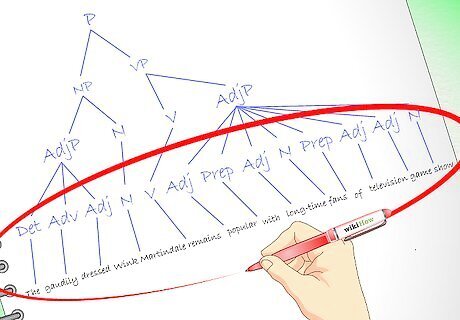
Connect each word to the label above it with a dotted vertical line. This shows the function of each word in the sentence; the tree branches show the relationships between components of the phrases that make up the sentence. For the example sentence, you’d draw a dotted line from ‘’The’’ to ’’Determiner’’ (or ‘’Article’’), from ‘’gaudily’’ to ‘’Adverb’’, from ‘’dressed’’ to ‘’Adjective’’, and so on.
Diagramming a Sentence (Reed-Kellogg Method)
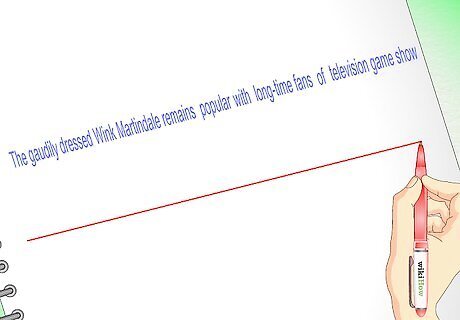
Draw a horizontal line. This is the line you will write the subject and predicate of the sentence on. For most of the steps in this section, we’ll use the same sentence as for the parse tree diagram example: ‘’The gaudily dressed Wink Martindale remains popular with long-time fans of television game shows’’. If you have a sentence composed of multiple independent clauses, make a line for each clause in the sentence.
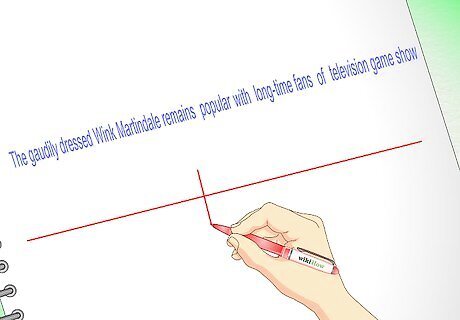
Draw a vertical line through the horizontal line. The vertical line separates the subject from the predicate.
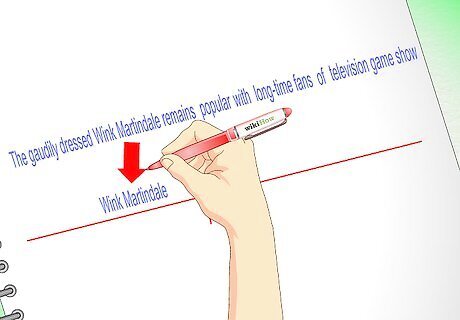
Write the subject of the sentence in front of the dividing line. See the step about where to look for the subject of the sentence in “Part Two: Analyzing a Sentence.” For this method of diagramming, we want only the simple subject of the sentence, not the complete noun phrase. For our example sentence, the simple subject is the proper noun ‘’Wink Martindale’’. If the sentence is an imperative (command) sentence, the subject is understood to be “you.” The subject is written on the line in parentheses, as “(you),” or as “(X).” If the sentence also includes a vocative (‘’Wink, tell us the categories.’’), put the vocative on a horizontal line floating above the understood subject. If the sentence has multiple subjects, draw a branch (a horizontal “V”) from the left of the subject-predicate divider and a separate line for each subject. Write each subject on one of the lines, and connect the subject lines with a dashed vertical line. Write the word ‘’and’’ on the dashed line.
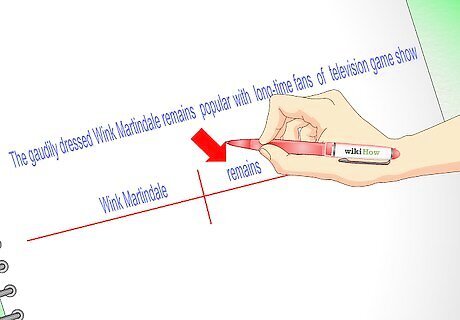
Write the main verb of the predicate after the dividing line. If the verb has a linking verb, write it in front of the main verb. For our example sentence, we’d write the verb ‘’remains’’ after the divider. If the sentence has multiple predicates, draw a branch from the right of the subject-predicate divider and a separate line for each predicate. Write each verb and linking verb (if any) on one of the lines and connect the predicate lines with a dashed vertical line. Write the word ‘’and’’ on the dashed line.
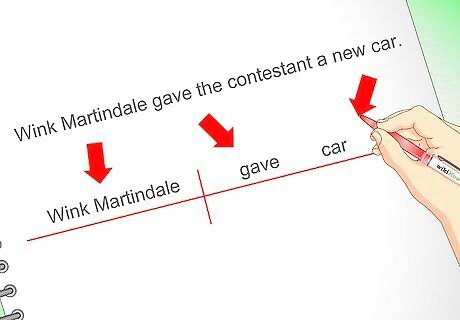
Fill in the direct object, if there is one. If the sentence has a direct object, it goes on the same line as the subject and predicate and is separated by a vertical line that rises upward from the subject-predicate line. Our original example sentence doesn’t have a direct object. However, if our sentence were ‘’Wink Martindale gave the contestant a new car.’’, the word ‘’car’’ would be written after the line dividing the predicate ‘’gave’’ from the direct object. If the sentence has one predicate but multiple objects, draw a branch from the right of the predicate-object divider and a separate line for each direct object. Write each direct object on one of the lines and connect the direct object line with a dashed vertical line on which you write ‘’and’’. If the sentence has multiple predicates with an object for each predicate, extend the predicate lines and draw in a vertical predicate object divider for each line, then write the objects that correspond to the predicates on the line of the predicate the object corresponds to. If the sentence has multiple predicates but only a single direct object, draw lines from each predicate line that converge at a single point. (This should mirror the branching out from the subject-predicate line, making the diagram look something like a wrapped candy.) Draw a horizontal line out from this point, with a predicate-object divider, then write the object to the right of the divider.
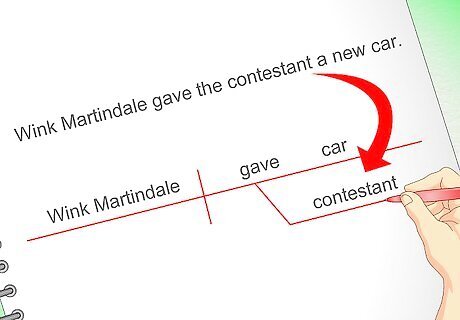
Fill in the indirect object, if there is one. Draw a slanting line from the predicate side of the subject-predicate line downward and to the right. Draw a horizontal line from the end of the slanting line and write the indirect object on it. Using our example sentence from the previous step, ‘’Wink Martindale gave the contestant a new car.’’, the word ‘’contestant’’ is the indirect object, so it would be written on the horizontal line below the predicate. If there are multiple indirect objects, draw a branch from the slanted line and a horizontal line for each indirect object. Write each indirect object on its own line and connect the indirect object lines with a vertical dashed line on which you write ‘’and’’.

Fill in the predicate noun or adjective if your sentence has one. A predicate noun or adjective goes in the same place as a direct object would, except that you separate it with a slanted line that points in the direction of the subject. This shows the predicate noun or adjective refers to or describes the subject. In our original sentence, the word “popular” is an example of a predicate adjective. If the sentence read ‘’Wink Martindale remains a popular game-show host.’’, the word ‘’host’’ would be an example of a predicate noun.
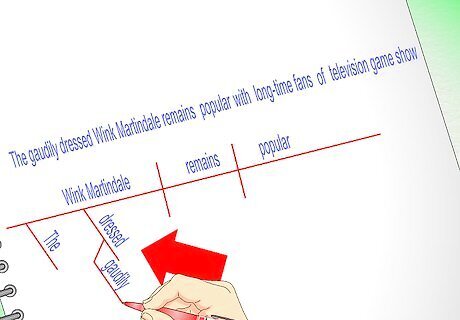
Fill in the words that describe the subject, predicate, and object. Draw diagonal lines under the subject(s), the predicate(s), and the object(s). Draw one line under the subject for each adjective that directly modifies the subject and write an adjective on it. If your sentence connects the adjectives together with ‘’and’’, draw a dashed line between the adjective lines and write ‘’and’’ on it. Using our original example sentence, the words ‘’The’’ and ‘’dressed’’ would appear on diagonal lines extending from the subject ‘’Wink Martindale’’. Draw one line under the predicate for each adverb that directly modifies the predicate and write an adverb on it. If your sentence connects the adverbs together with ‘’and’’, draw a dashed line between the adjective lines and write ‘’and’’ on it. Draw one line under the object for each adjective that directly modifies the object and write an adjective on it. If your sentence connects the adjectives together with ‘’and’’, draw a dashed line between the adjective lines and write ‘’and’’ on it. If you have adverbs that modify adjectives or other adverbs, draw a branching line from the modifier line downward and to the left. Then, draw a line perpendicular to this line but parallel to the modifier line. Write the modifying adverb on this line. Using our original example sentence, a branching line would be drawn from the line labeled with the word ‘’dressed’’. The word ‘’gaudily’’ would be written on the line paralleling ‘’dressed’’ to show it modifies that word.
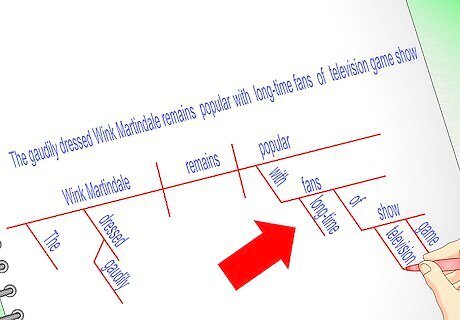
Fill in the prepositional phrases. The line segments for prepositional phrases look the same as for an indirect object, except that you write the preposition on the diagonal line that connects the object of the prepositional phrase to the subject-predicate line. However, while an indirect object always connects to the predicate, a prepositional phrase can be connected to the subject, predicate, object, an adjective, an adverb, or even to another prepositional phrase! Using our example sentence, we’d draw a diagonal line under the predicate adjective ‘’popular’’ and write the preposition ‘’with’’ on it, then draw a horizontal line and write the noun ‘’fans’’ on that. We would draw a diagonal line for the adjective ‘’long-time’’ and another diagonal line for the preposition ‘’of’’. We would draw a horizontal line from the preposition ‘’of’’ for the noun ‘’shows’’ and diagonal lines under ‘’shows’’ for the adjectives ‘’television’’ and ‘’game’’.
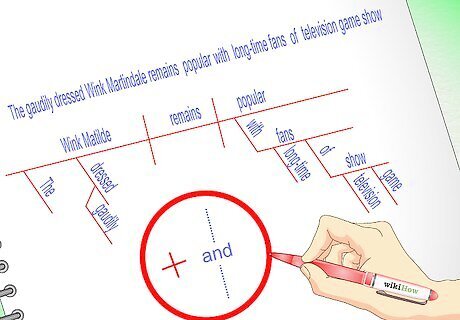
Connect independent clauses with a dashed vertical line. Just as you connect multiple subjects, predicates or objects together with a dashed vertical line with ‘’and’’ on it. If your sentence uses a different coordinating conjunction, use that in place of ‘’and’’. There are additional structures for more complex sentences, but these are the components you’ll find in most practice sentences. Search online for a graphic diagramming aid to help you master these.












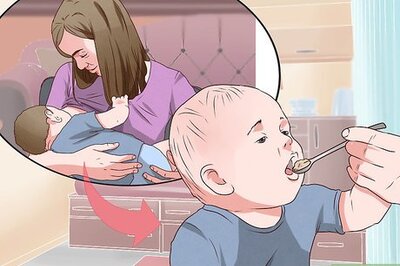
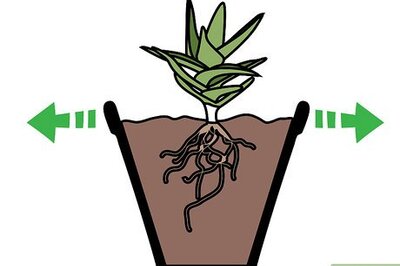

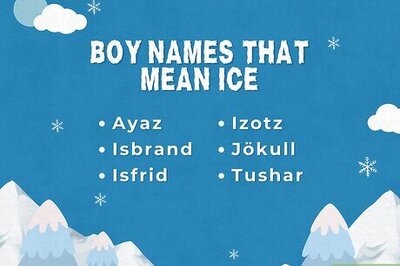


Comments
0 comment